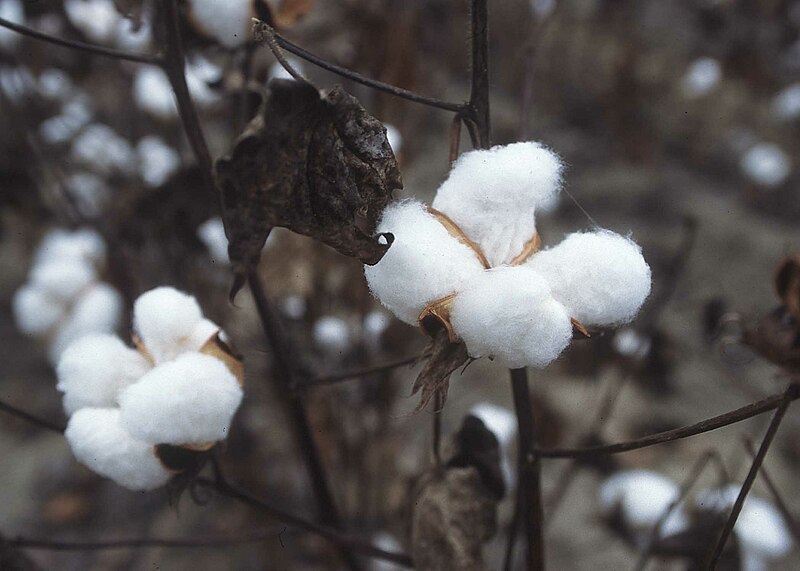Cotton
Common name: Cotton

Balls of cotton ready for harvest
USDA Natural Resources Conservation Service. [Public domain]
Cultivated cotton comprises hybrids that were derived from perennial shrubs of the genus Gossypium {Malvaceae). Cotton is commercially cultivated as an annual crop, mainly in temperate zones. In principle, cotton can survive and produce cotton bolls for more than one year at temperatures above 18°C, but this practice is not encouraged, mainly because of considerations of pest buildup. In the Middle East cotton is planted in spring, and the bolls mature in the late summer - early autumn. Both monopodia (vegetative branches) and sympodia (flower and fruit bearing branches) originate by budding from nodes on the monopodia. The flower is composed of five petals, arranged in a whorl. Cotton is mostly self-pollinated. It is grown mainly for lint - cellulose fibres, which are attached to the hull (seed-coat). The seeds are extracted for oil and the residual high-protein cottonseed meal is incorporated in farm-animal feed, as are the hulls, which may be incorporated into feed as roughage.
The cotton plant produces gossypol, a toxic, lipophylic compound that accumulates in the leaf glands, stems, fruit coat and in the seed. Residual gossypol is co-extracted in crude cottonseed oil, requiring further purification in order to reduce its content to acceptable levels. It binds to protein and has spermicidal activity. Cattle, sheep and goats degrade gossypol in the process of digestion, a process assisted by rumen bacteria.
Gossypol, and related Secondary plant constituents impart partial resistance against some cotton pests, as well as preventing other potential pests from developing on cotton. Gossypol-high and gossypol-low cultivars varieties have been bred. In the former, rigorous refining of the by-products (the oil and the extracted residue) adds to the cost of production. In contrast, the by-products of gossypol-low varieties require less refining, but such varieties are much more susceptible to pest damage. Since the primary purpose of the cotton crop is the quantity and quality of milled lint, the cultivation of low-gossypol varieties is not commercial.
The annual number of hectares planted to cotton is dependent on a variety of factors, such as supply and demand, the prevailing prices and the availability of inputs. For example, cotton production is augmented by copious irrigation, but water is limited in many parts of the Middle East. Crop damage attributable to insect pests, the cost of insecticides and of labor invested in their control, are additional major factors to be considered. The world cotton crop production has fluctuated from as low as 25 million bales per year to close to 50 millions bales in a period of 15 years (1984-1999). The major producers of cotton are the USA, with about 20 million bales and China with about 17 million. In comparison, cotton production in the Middle East is about 6 million bales. Turkey is in 6th place with respect to world cotton production, with about 4 million bales. Egypt and Syria each produce somewhat above 1 million bales and Israel about 0.1 million. The Izmir cotton region produces approximately 30% of Turkey’s total cotton production.
Crop quality may be adversely affected by above-average rainfall in Turkey, whereas in other areas of the Middle East, water scarcity is a limiting factor. About a third of the total irrigated area is planted to cotton in Syria. Although the use of insecticides is limited, insect damage is not a major factor in cotton production in Syria. Overall world supply and demand of cotton is buffered to some extent by stockpiling of about half of the yearly production, which may attenuate extreme price fluctuations.
Cotton pests in the Middle East
Management of cotton pests:
An insecticide resistance management program is currently implemented in the control of cotton pests in Israel. Its purpose is to limit the use of pyrethroids and other chemicals.
References
Horowitz, A.R., Seligman, I.M., Forer, G., Bar, D. & Ishaaya, I. 1993. Preventive insecticide resistance in Helicoverpa (Heliothis) armigera (Lepidoptera: Noctuidae) in Israeli cotton. Journal of Economic Entomology 86: 205-212.
Websites:
